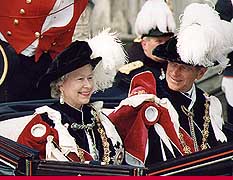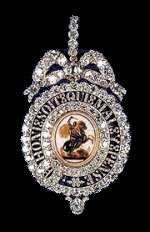 The
Following text and Photos are Copyright the Royal Collection and are reprinted
here by kind permission for Historical information. For their website go
here! The
Following text and Photos are Copyright the Royal Collection and are reprinted
here by kind permission for Historical information. For their website go
here!
The origin of the emblem of the Order, a blue garter,
is obscure. It is said to have been inspired by an incident which took
place whilst the King danced with Joan, Countess of Salisbury. The Countess's
garter fell to the floor and after the King retrieved it he tied it to
his own leg. Those watching this were apparently amused, but the King admonished
them saying, 'Honi soit qui mal y pense' (Shame on him who thinks
this evil). This then became the motto of the Order. Modern scholars think
it is more likely that the Order was inspired by the strap used to attach
pieces of armour, and that the motto could well have referred to critics
of Edward's claim to the throne of France.
The patron saint of the Order is St George (patron saint of soldiers and also of England) and the spiritual home of the Order is St George's Chapel, Windsor. Every knight is required to display a banner of his arms in the Chapel, together with a helmet, crest and sword and an enamelled stallplate. These 'achievements' are taken down on the knight's death (and the insignia are returned to the Sovereign), but the stallplates remain as a memorial and these now constitute one of the finest collections of heraldry in the world.
|
 Prince
Albert's Garter and George III's diamond Star. The Garter was worn beneath
the left knee: made in 1840. This Garter's motto is set in diamonds on
dark-blue velvet, and the buckle is set with one small and seven large
brilliants. The Star is worn on the left breast. Made in around 1800, George
III's Star had a 13-stone ruby cross centre set amongst diamonds in gold,
encircled by the Garter in blue enamel; the ends of the points still carry
the loops once used to sew the Star on to the wearer's coat
Prince
Albert's Garter and George III's diamond Star. The Garter was worn beneath
the left knee: made in 1840. This Garter's motto is set in diamonds on
dark-blue velvet, and the buckle is set with one small and seven large
brilliants. The Star is worn on the left breast. Made in around 1800, George
III's Star had a 13-stone ruby cross centre set amongst diamonds in gold,
encircled by the Garter in blue enamel; the ends of the points still carry
the loops once used to sew the Star on to the wearer's coat

 The
Queen and The Duke of Edinburgh ride in a carriage back to Windsor Castle,
after attending the annual Order of the Garter service at St George's Chapel,
Windsor. The Queen and Prince Philip were appointed to the Order by George
VI in 1947
The
Queen and The Duke of Edinburgh ride in a carriage back to Windsor Castle,
after attending the annual Order of the Garter service at St George's Chapel,
Windsor. The Queen and Prince Philip were appointed to the Order by George
VI in 1947

